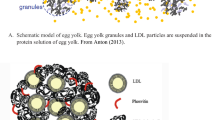Abstract
Egg yolk lipoprotein promoted growth of a wide variety of mammalian cell lines, including plasma-cytomas and epithelial cell lines, in serum-free medium. The lipoprotein was active for cell growth when used with insulin, transferrin, ethanolamine and selenite. The most active lipoprotein fraction (YLP-pI7.5) was purified to give a single peak by chromatofocusing and gel filtration, and was homogeneous on a 0.35% agarose gel electrophoretogram. The lipoprotein was characterised as a very low density lipoprotein with a protein content of only 1.3%. This lipoprotein had an optimal concentration of 300 μg/ml (4 μg protein/ml). It was easily separable from proteinous molecules secreted into the serum-free medium by the cells, since it floated on the surface of the medium after addition of ammonium sulfate, to precipitate protein, and centrifugation. An associated structure of lipid and protein seemed to be still necessary for the lipoprotein to exhibit a growth promoting activity.
Similar content being viewed by others
References
Bagenski ES, Foa PP and Zak B (1967) Microdetermination of inorganic phosphate, phospholipids and total phosphate in biological materials. Clin. Chem. 13: 326–332.
Bauer RF, Arther LO and Fine DL (1976) Propagation of mouse mammary tumor cell lines and production of mouse mammary tumor virus in a serum-free medium.In Vitro. 12: 558–563.
Bawen RE and Wolfe RC (1962) Observation on the cholesterol reaction: glacial acetic acid purity, a more sensitive absorbance peak, and bromide enhancement. Clin. Chem. 8: 296–309.
Bucolo G and David H (1973) Quantitative determination of serum triglycerides by the use of enzymes. Clin. Chem. 19: 476–482.
Fujii DK and Gospodarowicz D (1983) Chicken egg yolk supplemented medium and the serum-free growth of normal mammalian cells.In Vitro. 19: 811–817.
Fujii DK, Cheng J and Gospodarowicz D (1983) Phosphatidyl cholin and the growth in serum-free medium of vascular endothelial and smooth muscle cells, and corneal endo-thelial cells. J. Cell. Physiol. 114: 267–278.
Hashizume S, Kuroda K and Murakami H (1983) Identification of lactoferrin as an essential growth factor for human lymphocytic cell lines in serum-free medium. Biochim. Biophys. Acta. 763: 377–382.
Kawamoto T, Sato JD, Le A, McClure DB and Sato GH (1983) Development of a serum-free medium for growth of NS-1 mouse myeloma cells and its application to the isolation of NS-1 hybridomas. Anal. Biochem. 130: 445–453.
Martis MJ and Schwarz RI (1986) A simple fractionation of chicken egg yolk yields a protein component that stimulates cell proliferation and differentiation in primary avian tendon cells.In Vitro Cell. Dev. Biol. 22: 241–246.
McClure DB (1983) Anchorage-independent colony formation of SV40 transformed BALB/c-3T3 cells in serum-free medium: role of cell- and serum-derived factors. Cell. 32: 999–1006.
Murakami H, Masui H and Sato GH (1982-a) Suspension culture of hybridoma cells in serum-free medium: Soybean phospholipids as the essential components. In: Sato GH, Pardee AB, and Sirbasku DA (ed.) Growth of cells in hormonally defined media, pp. 711–715. Cold Spring Harbor Lab. New York.
Murakami H, Masui H, Sato GH, Sueoka N, Chow TP and Kano-Sueoka T (1982-b) Growth of hybridoma cells in serum-free medium: Ethanolamine is an essential component. Proc. Natl. Acad. Sci. USA. 79: 1158–1162.
Murakami H, Shimomura T, Nakamura T, Ohashi H, Shinohara K and Omura H (1984) Development of a basal medium for serum-free cultivation of hybridoma cells in high density. J. Agricult. Biol. Chem. 58: 575–583.
Murakami H, Hashizume S, Ohashi H, Shinohara K, Yasumoto K, Nomoto K and Omura H (1985-b) Human-human hybridomas secreting antibodies specific to human lung carcinoma.In Vitro Cell. Dev. Biol. 21: 593–596.
Murakami H, Shimomura T, Ohashi H, Hashizume S, Tokashiki M, Shinohara K, Yasumoto K, Nomoto K and Omura H (1985-a) Serum-free culture of human-human hybridoma lines. In: Murakami H, Yamane I, Barnes DW, Mather JP, Hayashi I and Sato GH (ed.) Growth and Differentiation of Cells in Defined Environment, pp. 111–116. Kodansha/Springer-Verlag, Tokyo/Berlin.
Shipley GO and Ham RG (1983) Multiplication of Swiss 3T3 cells in a serum-free medium. Exp. Cell Res. 146: 249–260.
Takazawa Y, Murakami H, Yamada K, Tokashiki M and Omura H (1987) High density culture of mouse-human hybridoma in serum-free defined medium. Biotech. & Bioengineering. In press.
Author information
Authors and Affiliations
Rights and permissions
About this article
Cite this article
Murakami, H., Okazaki, Y., Yamada, K. et al. Egg yolk lipoprotein, a new supplement for the growth of mammalian cells in serum-free medium. Cytotechnology 1, 159–169 (1988). https://doi.org/10.1007/BF00146817
Received:
Accepted:
Issue Date:
DOI: https://doi.org/10.1007/BF00146817




